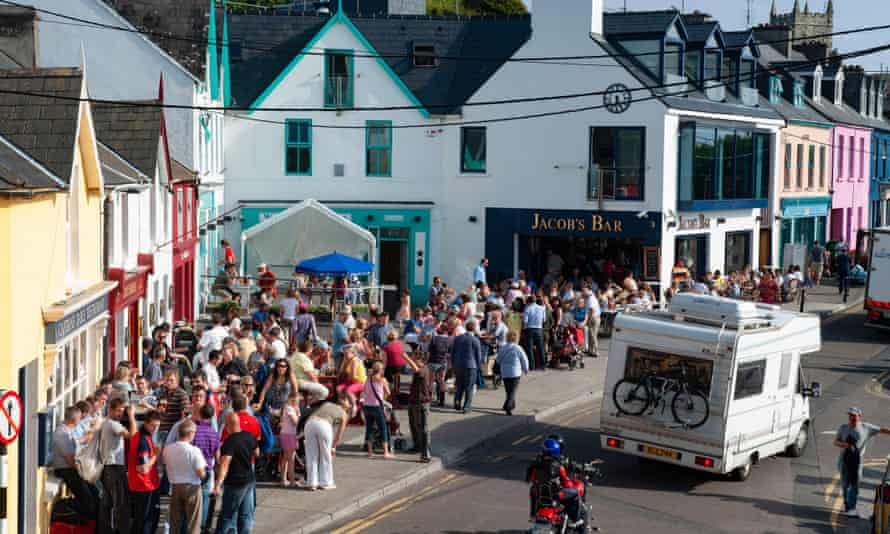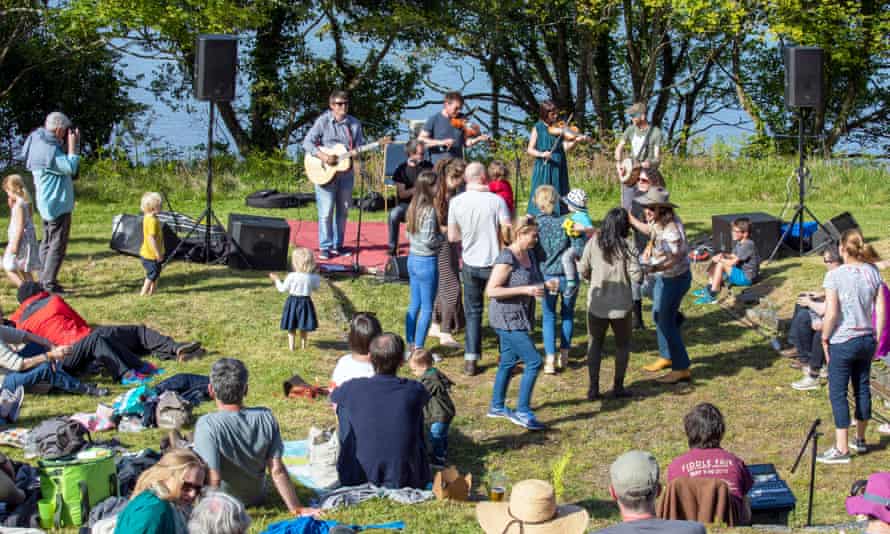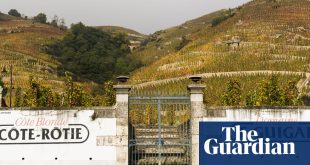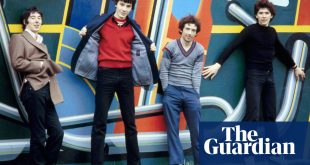It’s difficult for things to go quiet in an Irish bar, but right now you can hear a bone button drop. An eight-year-old girl called Aibhlinn is sitting on the floor astride her instrument case playing her squeezebox with rapt concentration, swaying as she gives the opening solo to The South Wind. Along the wall of the bar, a dozen fiddle players have their bows raised ready to charge the minute she finishes.
But she’s in no hurry. This is her moment and she’s taking it. Each time she reaches the end of a musical phrase, there is a respectful pause to see if she’ll start up again – and she does, playing with a determined and mature deliberation. Finally though, she reaches the delicate end of the intro and the fiddlers, led by Eoín O’Sullivan, charge in, followed by the surrounding accordions, guitars and flutes. A harmonica wails. The whole bar feels like it might be taking off.
Over the long weekend of the annual Baltimore Fiddle Fair, there are many such sessions in the bars that line the harbour of this village in County Cork, Ireland. I notice there’s a courteous and egalitarian approach to proceedings. When a group is playing – often a few fiddlers, a guitarist and somebody on the spoons – and a new musician approaches, they will tactfully sit at the end of the table, nursing a drink until invited to participate. Then he or she will lay down a tune, set up the tempo, and the others will slowly join in as they come up to speed.
It must be one of the few music festivals in the world where the majority of people attending are musicians themselves. Around town, you can’t get by on the pavements for pedestrians carrying violin and guitar cases.

When we first drove to Baltimore down the narrow country lanes from Cork – the sort of roads where, as the locals say, you need to breathe in if you meet another car – we picked up a couple of hitchhikers. Leo had brought his fiddle all the way from Brazil, while his friend Casey was Irish– they were typical of the mix at what has become a very international celebration. Typically, too, within five minutes we had heard the entire history of their musical and emotional journeys.
The Baltimore Fiddle Fair has been gently gathering pace since 1992 when Declan McCarthy first decided to have a week of music at Jacob’s Bar on the village square. As well as the open sessions in bars that still make up the heart of the fair, more formal concerts are now held in a large marquee, local churches and at Glebe Gardens. Some performances even take place on a yacht that sails round the harbour.
But it’s still an intimate affair, with hundreds rather than thousands of attendees. And that’s the way Declan, a softly-spoken, tall man now in his 50s, plans to keep it: “We’d like to get better without getting any bigger. We’re at the end of the road here, right on the southwestern tip of Ireland. You have to want to come – because there’s no way you’re going to be just passing through. You have to show commitment.”

Declan seems preternaturally calm during the busy proceedings of the festival weekend, the only time I see him bridle is when someone suggests it’s a festival celebrating “traditional Irish music”. “It’s not just Irish! – or for that matter traditional. The whole point is we get all sorts. It’s a fiddle fair. So we have bluegrass from the States or for that matter a woman from China called Ling Peng playing a two-stringed fiddle who went down a storm. Now that might not have worked when we started – the locals in Jacob’s Bar would have said, “Wa’ the fuck!” But it’s certainly where we’ve arrived.”
This part of West Cork is known for its Sliabh Luachra tradition. Eoín O’Sullivan, the fiddle fair’s musician-in-residence, who led many of the sessions with a rhythmic drive that reminded me of hardcore techno, explained how this differs from other forms of Irish music. “The Donegal landscape is stony and maybe that makes for a harder sound. The Sliabh Luachra tradition you find down in Cork and Kerry is a softer affair, and that comes from the water and our bogs and green hills. Some of the bogs here are so big you can almost hear a drone coming out of them! We’ll play polkas and airs along with the reels and jigs.”

What struck me as a listener was the way in which the best of the music, from wherever it came in the world, was full of yearning: fiddles that took off and never stopped twisting and turning, like a hare trying to get out of a field. Some musicians played so hard that they left a white residue of rosin from the bow, around the bridge of their instrument.
It can be an intense three or four days, but those wanting, or needing, to walk off the Murphy’s in the mornings are spoilt for choice. Baltimore lies near three fingers of land that protrude into Roaringwater Bay and the Atlantic. The finest of these for hiking is the Sheep’s Head peninsula, with a fabulous trail that snakes along its length. If you don’t want to do the whole thing, pick off the last section, the Peekeen Ridge, for spectacular views either side.
Looking north on a brilliantly clear day, we could see the mountains of MacGillycuddy’s Reeks in Kerry, some of Ireland’s highest; to the south, the islands of Roaringwater Bay with their evocative names – Hare Island, Horse Island and Cape Clear among them – and furthest out of all, the iconic black rock of Fastnet.
I passed a megalithic burial chamber right on the sharp edge of the Peekeen Ridge. The whole area is rich in prehistoric remains: at nearby Dunbeacon, a stone circle in a farmer’s field is still intact, surrounded by yellow gorse bushes.
In a neighbouring plot, I came across an old burial ground dating back to the time of the Irish famine. The cheap gravestones had been put up in profusion, and were so small that now only the very tops poked up over the grass that grew high around them.

This area of Ireland was hit particularly hard by the great famine in the 1840s and 50s. On Sherkin Island, just over the water from Baltimore, the population dropped from 1,131 people in 1841 to 350 by the turn of the century. Many of the survivors emigrated to Newfoundland, where traces of the County Cork accent can still be heard. Only a hundred or so people live on the island today – a wild and beautiful place to stay for the festival, just a short ferry trip from the mainland.
Back in Baltimore, I was fortified by a quite excellent crab sandwich from Bushe’s Bar, where some fiddlers led by a mother and her daughter were playing an elegiac air. Perhaps because I had just returned from the burial ground, I was more aware of the undercurrent of sadness that ran through some of the melodies.
An older man beside me at the bar was shyly strumming along on a ukulele while the mother and daughter played at their table. “It’s my first time here,” he explained, “and there are some very good musicians. So I’m playing softly in the background and just hope I can keep up!”
Declan has a close involvement with the Celtic Connections festival in Glasgow and plans to take a travelling version of the Fiddle Fair on the road at some stage. But it’s still best to make “the commitment” and head to Baltimore itself, for four days of intense fiddle music at its very finest. Although, given that many of the sessions last until three in the morning, plenty of others may find it hard to keep up.
The Baltimore Fiddle Fair will take place from 5-8 May. Weekend tickets cost €130-€150pp, gig tickets €15-€30pp, fiddlefair.com
 Top Naija News: Nigerian News, Breaking News Nigeria and World News Top Naija News is a daily news publication in Nigeria, delivering the latest breaking news in Nigeria and around the world.
Top Naija News: Nigerian News, Breaking News Nigeria and World News Top Naija News is a daily news publication in Nigeria, delivering the latest breaking news in Nigeria and around the world.



